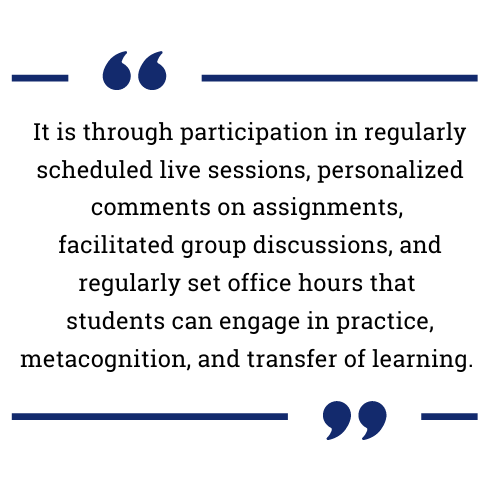Regular and Substantive Interaction: Resources to Support Learning, Neuroplasticity, and Regulations
Published by: WCET | 3/2/2023
Tags: Distance Education, Online Learning, Regular And Substantive Interaction, Regulation, Student Success
Published by: WCET | 3/2/2023
Tags: Distance Education, Online Learning, Regular And Substantive Interaction, Regulation, Student Success
Today’s blog explores Regular and Substantive Interaction through a learning science-based approach to course design and instruction. Thank you to Kristen Betts, Clinical Professor at Drexel University, and Karyn Holt, Vice President of Institutional Partnerships & Research at INTERACT123, for the resources and innovative way to consider the learning process, especially regulations regarding that process, and how we can ensure the best learning opportunities for our students.
Enjoy the read,
Lindsey Downs, WCET

Educators are brain changers. Research in neuroscience and advancements in technology provide critical insight about the brain and learning. According to Dr. Lara Boyd (2015),a neuroscientist and physical therapist at the University of British Columbia, “Every time you learn a new fact or skill, you change your brain. It is something we call neuroplasticity.”
Neuroplasticity is the ability of the brain to change and adapt in structure and function throughout the lifespan in response to experience and the environment in which one interacts (Boutzoukas & Woods, 2022; CAST, 2018; Costandi, 2016; Cunnington, 2019). The brain is a highly complex and dynamic organ that receives, processes, and interprets information. With approximately 100 billion neurons and over 100 trillion synaptic connections, “there are more neurons in a single human brain than stars in the milky way!” (Colón-Ramos Lab, 2023).
Educators do not need to become experts in neuroscience. However, having foundational knowledge about the brain can expand the understanding of the human learning process and assist in debunking myths such as individuals using only 10% of the brain or being either left- or right-brained, which may negatively impact learning and mindsets. Research indicates that an educator’s knowledge and epistemological beliefs are influential variables that can affect pedagogical practice (Gholami et al., 2022; Lee et al., 2013; Mataka et al., 2019). Therefore, increasing awareness and understanding about the brain and neuroplasticity can provide new insights for designing, teaching, and assessing courses. It can also support aligning practices to meet student learning outcomes and federal regulations.
The Final Rules on Distance Education and Innovation, issued by the U.S. Department of Education, went into effect on July 1, 2021. These regulations included a new definition of academic engagement. Additionally, the definition of distance education, which is used in determining financial aid eligibility for higher education institutions, was updated with “regular and substantive interaction” being a key differential between “distance education” and “correspondence education” (Kerensky, 2021; Federal Student Aid, 2021; Office of Postsecondary Education, 2020). The concept of regular and substantive interaction is not new to higher education nor is the discussion on the differences between distance education and correspondence education. WCET has cited regular and substantive interaction as one of the “Top WCET Frontiers Blog Posts” since 2020 (Raymond, 2021; Downs, 2020; Davis & Poulin, 2016). Furthermore, WCET brought national attention to the practical and philosophical considerations of correspondence definitions in an April 2012 blog on “Is Your Distance Education Course Actually a Correspondence Course?” (Poulin, 2012). Since the release of the regulations, WCET, Online Learning Consortium, Quality Matters, and UPCEA have been at the forefront of providing updates and clarity on the definitions.

Distance education is defined by the U.S. Department of Education at the course level, which makes both course design and instruction of great importance.
It is recommended that educators carefully compare the prior and updated definitions for distance education since key terms, including instructor, substantive, and regular, were previously not defined as shared in the “Distance Education and Institutional Eligibility Webinar” on April 26, 2021 (Musser & Martin, 2021).
Distance Education means: Education that uses one or more of the technologies listed in paragraphs (1) through (4) to deliver instruction to students who are separated from the instructor and to support regular and substantive interaction between the students and the instructor, either synchronously or asynchronously. The technologies may include:
(1) the internet;
(2) one-way and two-way transmissions through open broadcast, closed circuit, cable, microwave, broadband lines, fiber optics, satellite, or wireless communications devices;
(3) audioconferencing; or
(4) video cassettes, DVDs, and CD-ROMs, if the cassettes, DVDs, or CD-ROMs are used in a course in conjunction with any of the technologies listed in paragraphs (1) through (3).
Distance education: (1) Education that uses one or more of the technologies listed in paragraphs (2)(i) through (iv) of this definition to deliver instruction to students who are separated from the instructor or instructors and to support regular and substantive interaction between the students and the instructor or instructors, either synchronously or asynchronously.
(2)The technologies that may be used to offer distance education include –
(i) The internet;
(ii) One-way and two-way transmissions through open broadcast, closed circuit, cable, microwave, broadband lines, fiber optics, satellite, or wireless communications devices;
(iii) Audio conference; or
(iv) Other media used in a course in conjunction with any of the technologies listed in paragraphs (2)(i) through (iii) of this definition.
(3) For purposes of this definition, an instructor is an individual responsible for delivering course content and who meets the qualifications for instruction established by an institution’s accrediting agency.
(4) For purposes of this definition, substantive interaction is engaging students in teaching, learning, and assessment, consistent with the content under discussion, and also includes at least two of the following –
(i) Providing direct instruction;
(ii) Assessing or providing feedback on a student’s coursework;
(iii) Providing information or responding to questions about the content of a course or competency;
(iv) Facilitating a group discussion regarding the content of a course or competency; or
(v) Other instructional activities approved by the institution’s or program’s accrediting agency.

(5) An institution ensures regular interaction between a student and an instructor or instructors by, prior to the student’s completion of a course or competency –
(i) Providing the opportunity for substantive interactions with the student on a predictable and scheduled basis commensurate with the length of time and the amount of content in the course or competency; and
(ii) Monitoring the student’s academic engagement and success and ensuring that an instructor is responsible for promptly and proactively engaging in substantive interaction with the student when needed on the basis of such monitoring, or upon request by the student.
The updated definition brings increased focus on the significant role of the instructor in delivering distance education course content with greater elaboration on both regular and substantive interaction.
Regular and substantive interaction, referred to as RSI, should not be seen as an incumbrance or be the last section of a course review checklist. Understanding “what is and what is not considered to be RSI” is critical to course design and instruction (Mesa Community College; University of Houston; University of Wisconsin-Madison).
RSI aligns with evidence-based practices that build upon the neuroscience of learning. Understanding the brain is not a muscle but a dynamic network of interconnected neurons, is important for all educators. According to Fields (2021), “The connecting points between neurons, called synapses, are where learning is thought to occur. Learning and memory require the coupling of information from many different brain regions. This activity alters the physical structure of myelin, the insulating material surrounding the wiring that connects neurons. Myelin, it turns out, plays a key role in learning by adjusting the speed of information” (p. 74). Hence, it is not “muscle memory” that educators should be focused on but the integration of activities, experiences, and feedback into distance education courses that support engagement and effective practice to promote myelination.
The integration of RSI into course design and delivery not only supports alignment with regulations but also supports alignment with Universal Design for Learning (UDL) and inclusive teaching practices. Each student enrolled in a distance education course is truly unique. According to CAST (2018), “Like fingerprints, no two brains are alike. Each brain is a complex, interconnected web that is sculpted and influenced by genetics and interactions with the environment” (p. 1). Substantive interaction supports engaging students in teaching, learning, and assessment. Understanding that “UDL is a framework to improve and optimize teaching and learning for all people based on scientific insights into how humans learn,” (CAST, n.d.) provides a strong foundation to support learner variability through multiple means of engagement (the “why” of learning; affective networks), representation (“what” of learning; recognition networks), and action and expression (“how” of learning; strategic networks).
Inclusive teaching practices can be integrated into distance education courses to support substantive interaction.

To ensure that courses reflect a diverse society and world, the Association of College and University Educators (2022) shares, “Be intentional when selecting your multimedia (images, videos, blogs), required readings, and illustrative examples so that your course site and curriculum reflect diverse people, voices, and viewpoints” (para. 3). As educators look for content to support discussions, live sessions, and assignments, choosing content that reflects the diverse world in which we live can support an inclusive learning environment that fosters belonging, engagement, and deeper learning.
Finally, regular and substantive interaction must be predictable and scheduled with opportunities for direct interaction with students. Furthermore, the instructor is responsible for promptly and proactively engaging in substantive interaction with students. This is particularly important with feedback on assignments and facilitating discussions. As shared by CAST (2018), “Frequent, formative feedback and opportunities for active learning create and strengthen the connections within our learning brains” (p. 2). It is through participation in regularly scheduled live sessions, personalized comments on assignments, facilitated group discussions, and regularly set office hours that students can engage in practice, metacognition, and transfer of learning. It is important to remember as brain changers that “Every lesson, assignment, and interaction shapes your students’ brains” (McTighe & Willis, 2019, p. 3).
Here are four resources that have additional support and information on learning, neuroplasticity, and regulations:
WCET (WICHE Cooperative for Educational Technologies) is an eminent leader in the practice, policy, and advocacy of digital learning in higher education. WCET provides the latest research and updates on policies and regulations related to distance education and Regular and Substantive Interaction. WCET’s Frontiers Blog provides critical insight on current and emerging issues. WCET continues to lead the national discussion on the Final Rules on Distance Education and Innovation. WCET’s conferences and webcasts, including speakers and panels, focus on topics that support faculty and student success.
The Online Learning Consortium (OLC) is a pioneering organization that continues to advance online learning. OLC brings together innovators, leaders, faculty, instructional designers, administrators, and trainers as well as educational institutions, professional societies, and corporate enterprises as part of a dynamic higher education community. OLC offers workshops, webinars, mastery series, and certificate programs to support professional development. The Neuro, Cognitive & Learning Sciences (NCLS) series includes four workshops: Part 1: Bringing Theory to Practice; Part 2: Applying Theory to Practice; Regular & Substantive Interaction, Policy & Practice; and Instructional Design. All of the NCLS workshops support learning, neuroplasticity, and regulations. The Nursing Mastery Series also integrates content related to neuroscience of learning, regulations, and alignment with accreditation.
The OSCQR SUNY Online Course Quality Review Rubric was developed in collaboration with campuses throughout the SUNY system to address the instructional design and accessibility of an online course. The OSCQR rubric supports continuous improvements to the quality and accessibility of online courses. The SUNY Online Course Quality Review Rubric website provides access to the OSCQR rubric, detailed updates on Regular and Substantive Interaction, and resources related to OSCQR research.
INTERACT123 provides extensive resources and a learning science-based application for instructional designers and instructors to support CLEAR Course Design: Credit Hour, Licensure, Engagement, Accreditation, and Regular & Substantive Interaction. The Regular & Substantive Interaction (RSI) One-Stop includes the latest updates, guidelines, checklists, and rubrics to support alignment with the regulations. INTERACT123 resources include key topics on the brain and learning, assessment and cognitive load, and more. INTERACT123 has an interactive Myths & Facts Self-Assessment that allows you to check your awareness of key topics related the brain, teaching, and learning. Current insights on educational topics are provided through the INTERACT123 Monograph Series and Research Round-up. Powered by AWS, INTERACT123 enables higher education institutions to balance content, workload, and cognitive load to support student success.
Clinical Professor, Drexel University
Vice President, Institutional Partnerships & Research, INTERACT123